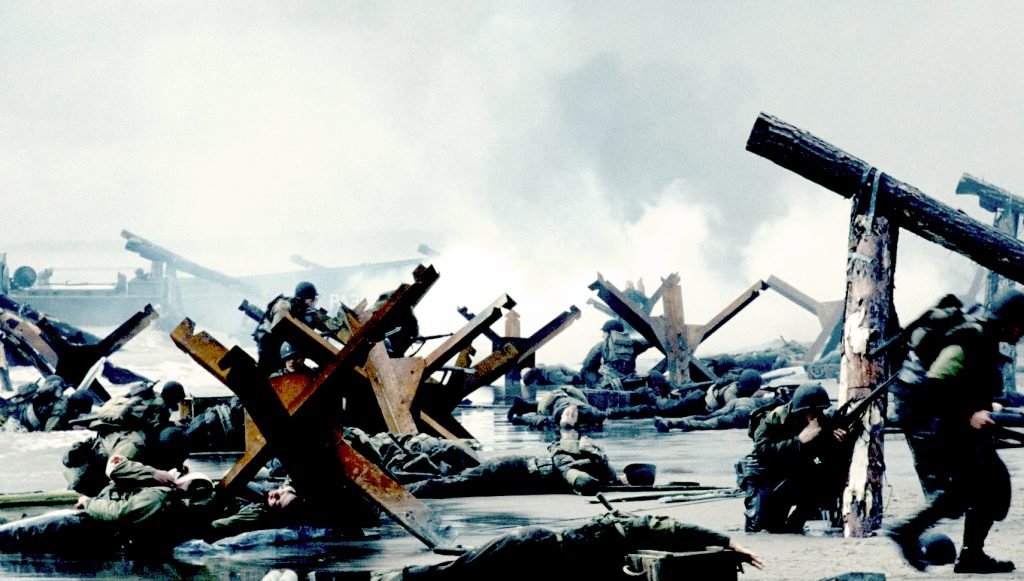
Edited screenshot from Saving Private Ryan/Dreamworks Pictures.
On June 6, 1944, Allied forces launched Operation Overlord, parachuting into France and landing along five beaches of the Normandy coast to start the liberation of Nazi-occupied Europe. The D-Day landings are still the largest amphibious assault in history, and no film has captured the monumental battle quite like Steven Spielberg’s Saving Private Ryan.
The opening scene uses thousands of real extras — most of whom are Irish soldiers — and relies heavily on practical special effects. It’s shot mostly with unstable hand-held cameras creating a documentary-style feel that sets the gold standard for authentic war films. But what really sets the bar so high is the use of sound, a task given to sound designer Gary Rydstrom.
A 2004 mini-documentary revealed how Spielberg didn’t want the movie to sound “Hollywood,” meaning he didn’t want the sound department to rely on lots of prerecorded sound effects. Instead Rydstrom and the sound department recorded and cut each sound effect individually, then spliced them together for the final cut.

The infamous Omaha Beach scene runs over 20 minutes and is completely void of music. After a tense ride to the beach in a claustrophobic Higgins boat, the ramp drops, and the audience is hit with the first sounds of combat.
Unlike other war movies, Saving Private Ryan doesn’t fill the atmosphere solely with noises of guns firing. Instead, the first boatload of soldiers to hit the beach are chewed up by a German machine gun to the sounds of bullets smacking flesh and the whiz of near-misses. The gun noises are an afterthought. The revolutionary approach to capturing the sounds of combat make it immediately clear that Saving Private Ryan is a different kind of war movie.
As the chaos of D-Day unfolds on screen, the din swells into a cacophony. Rydstrom does this by creating different sound effects for bullets impacting sand, water, metal, and people. In order to re-create some of the noises typically found only in the middle of combat, his team had to get creative. To mimic the sound of bullets slicing through water, Rydstrom borrowed the sound of a fly-fishing line being yanked off the surface of a river: a sound he originally recorded for A River Runs Through It.
The 20 minutes of unrelenting noise is graciously broken up twice. First, as men stumble through the surf to get ashore, the camera bobs underneath the water, creating an eerie silence that’s immediately shattered when the camera reemerges. The second time occurs when Capt. John Miller — played by Tom Hanks — experiences a moment of shock. When he finally crawls out of the water onto Omaha Beach, his senses are momentarily overwhelmed, and his hearing is diminished.
To create the effect for the audience, Rydstrom recorded ocean sounds, then recorded the playback with a microphone placed at the end of a long tube. The result is a clever way of giving the audience a taste of what Miller is experiencing. The technique is so effective that the filmmakers use it a second time during the movie’s climactic battle.
The entire movie is a masterpiece, but it’s the opening scene that lives on as the movie’s biggest achievement. Without it, it’s likely that Saving Private Ryan wouldn’t have won five Oscars. Beginning with over 20 minutes of brutal combat and no accompanying score is an exhausting start to the nearly three-hour movie. It’s not until Capt. Miller takes the second swig of his canteen that the audience realizes they’ve been holding their breath. It takes several rewatches to truly appreciate the scene’s accomplishment; in particular, its achievement in sound.
If you don’t have time to rewatch the entire movie, at least trade 20 minutes of phone-scrolling to experience the complex sounds of Spielberg and Rydstrom’s D-Day re-creation. To get the full effect, use a pair of quality headphones and turn the volume up to an uncomfortable level.
Read Next: Ranger Who Landed at Normandy and Inspired Generations Dies Before D-Day Anniversary

Mac Caltrider is a senior staff writer for Coffee or Die Magazine. He served in the US Marine Corps and is a former police officer. Caltrider earned his bachelor’s degree in history and now reads anything he can get his hands on. He is also the creator of Pipes & Pages, a site intended to increase readership among enlisted troops. Caltrider spends most of his time reading, writing, and waging a one-man war against premature hair loss.
BRCC and Bad Moon Print Press team up for an exclusive, limited-edition T-shirt design!
BRCC partners with Team Room Design for an exclusive T-shirt release!
Thirty Seconds Out has partnered with BRCC for an exclusive shirt design invoking the God of Winter.
Lucas O'Hara of Grizzly Forge has teamed up with BRCC for a badass, exclusive Shirt Club T-shirt design featuring his most popular knife and tiomahawk.
Coffee or Die sits down with one of the graphic designers behind Black Rifle Coffee's signature look and vibe.
Biden will award the Medal of Honor to a Vietnam War Army helicopter pilot who risked his life to save a reconnaissance team from almost certain death.
Ever wonder how much Jack Mandaville would f*ck sh*t up if he went back in time? The American Revolution didn't even see him coming.
A nearly 200-year-old West Point time capsule that at first appeared to yield little more than dust contains hidden treasure, the US Military Academy said.












